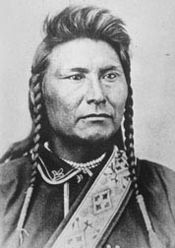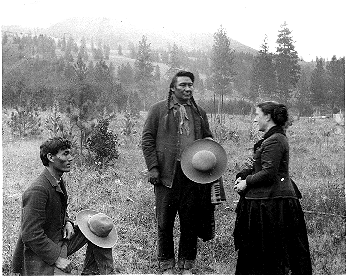forum
library
tutorial
contact

103 Years Since Chief Joseph
by Various AuthorsWikipedia, September 21, 2007
|
the film forum library tutorial contact |

|
103 Years Since Chief Josephby Various AuthorsWikipedia, September 21, 2007 |
 Background
Background
Born Hinmuuttu-yalatlat (alternatively Hinmaton-Yalaktit or Hin-mah-too-yah-lat-kekt, Nez Perce: "Thunder Rolling Down Mountain") in the Wallowa Valley of northeastern Oregon, he was known as Young Joseph during his youth because his father had the same name.
While initially hospitable to the region's newcomers, Joseph the Elder grew wary when settlers became greedy for more Indian lands. Tensions grew as the settlers appropriated traditional Indian lands for farming and grazing livestock.
Isaac Stevens, governor of the Washington Territory, organized a council to designate separate areas for Natives and settlers in 1855. Joseph the Elder and the other Nez Perce chiefs signed a treaty with the United States establishing a Nez Perce reservation encompassing 7.7 million acres (31,000 square-kilometers) in present-day Idaho, Washington, and Oregon. The 1855 reservation maintained much of the traditional Nez Perce lands, including Joseph's Wallowa Valley.
An influx of new settlers caused by a gold rush led the government to call a second council in 1863. Government commissioners asked the Nez Perce to accept a new, much smaller reservation of 780,000 acres (3200 square-kilometers) centered around the village of Lapwai in Idaho, and excluding the Wallowa Valley. In exchange, they were promised financial rewards and schools and a hospital for the reservation. Head Chief Lawyer and one of his allied chiefs signed the treaty on behalf of the Nez Perce Nation, but Joseph the Elder and several other chiefs were opposed to selling their lands, and did not sign.
Their refusal to sign caused a rift between the "non-treaty" and "treaty" bands of Nez Perce. The "treaty" Nez Perce moved within the new Idaho reservation's boundaries, while the "non-treaty" Nez Perce remained on their lands. Joseph the Elder demarcated Wallowa land with a series of poles, proclaiming, "Inside this boundary all our people were born. It circles the graves of our fathers, and we will never give up these graves to any man."
As Chief
 Joseph the Younger succeeded his father as chief in 1871. Before his death, this latter counseled his son:
Joseph the Younger succeeded his father as chief in 1871. Before his death, this latter counseled his son:
"My son, my body is returning to my mother earth, and my spirit is going very soon to see the Great Spirit Chief. When I am gone, think of your country. You are the chief of these people. They look to you to guide them. Always remember that your father never sold his country. You must stop your ears whenever you are asked to sign a treaty selling your home. A few years more, and white men will be all around you. They have their eyes on this land. My son, never forget my dying words. This country holds your father's body. Never sell the bones of your father and your mother."Chief Joseph commented "I clasped my father's hand and promised to do as he asked. A man who would not defend his father's grave is worse than a wild animal."
The non-treaty Nez Perce suffered many injustices at the hands of settlers and prospectors, but out of fear of reprisal from the militarily superior Americans, Joseph never allowed any violence against them, instead making many concessions to them in hopes of securing peace.
In 1873, Chief Joseph negotiated with the federal government to ensure his people could stay on their land in the Wallowa Valley. But in 1877, the government reversed its policy, and Army General Oliver Howard threatened to attack if the Wallowa band did not relocate to the Idaho Reservation with the other Nez Perce. Chief Joseph reluctantly agreed.
Before the outbreak of hostilities, General Howard held a council to try to convince Joseph and his people to relocate. Joseph finished his address to the General, which focused on human equality, by expressing his "[disbelief that] the Great Spirit Chief gave one kind of men the right to tell another kind of men what they must do."
Howard reacted angrily, interpreting the statement as a challenge to his authority. When Chief Too-hul-hul-sote protested, he was jailed for five days.
The day following the council, Joseph, White Bird, and Looking Glass all accompanied General Howard to look at different areas. Howard offered them a plot of land that was inhabited by Whites and Indians, promising to clear them out. Joseph and his chieftains refused, adhering to their tribal tradition of not taking what did not belong to them.
Unable to find any suitable uninhabited land on the reservation, Howard informed Joseph that his people had thirty days to collect their livestock and move to the reservation. Joseph pleaded for more time, but Howard told him that he would consider their presence in the Wallowa Valley beyond the thirty-day mark an act of war.
Returning home, Joseph called a council among his people. At the council, he spoke on behalf of peace, preferring to abandon his father's grave over war. Too-hul-hul-sote, insulted by his incarceration, advocated war.
The Wallowa band began making preparations for the long journey, meeting first with other bands at Rocky Canyon. At this council too, many leaders urged war, while Joseph argued in favor of peace.
While the council was underway, a young man whose father had been killed rode up and announced that he and several other young men had already killed four white men, an act sure to initiate war.
Still hoping to avoid further bloodshed, Joseph and other Nez Perce chiefs began leading his people north toward Canada. Only sixteen miles away, they were attacked, and Joseph began a strategic retreat now regarded as one of the greatest of all military history[citation needed].
Retreat and Surrender
With 2000 U.S. soldiers in pursuit, Joseph and other Nez Perce chiefs led 800 Nez Perce toward freedom at the Canadian border. For over three months, the Nez Perce outmaneuvered and battled their pursuers traveling 1,700 miles across Oregon, Washington, Idaho, Wyoming, and Montana.
General Howard, leading the opposing cavalry, was impressed with the skill with which the Nez Perce fought, using advance and rear guards, skirmish lines, and field fortifications. Finally, after a devastating five-day battle during freezing weather conditions with no food or blankets, Chief Joseph formally surrendered to General Nelson Appleton Miles on October 5, 1877 in the Bear Paw Mountains of the Montana Territory, less than 40 miles (60 km) south of Canada in a place close to the present-day Chinook in Blaine County. The battle is remembered in popular history by the words attributed to Chief Joseph at the formal surrender:
"Tell General Howard I know his heart. What he told me before, I have it in my heart. I am tired of fighting. Our chiefs are killed; Looking Glass is dead, Too-hul-hul-sote is dead. The old men are all dead. It is the young men who say yes or no. He who led on the young men is dead. It is cold, and we have no blankets; the little children are freezing to death. My people, some of them, have run away to the hills, and have no blankets, no food. No one knows where they are-perhaps freezing to death. I want to have time to look for my children, and see how many of them I can find. Maybe I shall find them among the dead. Hear me, my chiefs! I am tired; my heart is sick and sad. From where the sun now stands, I will fight no more forever."The popular legend deflated, however, when the original pencil draft of the report was revealed to show the handwriting of the later poet and lawyer Lieutenant C.E.S. Wood, who claimed to have taken down the great chief's words on the spot. In the margin it read, "Here insert Joseph's reply to the demand for surrender"
Although Joseph was not technically a warchief, and probably did not command the retreat, many of the chiefs who did had already died. His speech brought attention, and therefore credit, his way. He earned the praise of General William Tecumseh Sherman, and became known in the press as "the Red Napoleon".
Aftermath
Joseph's fame did him little good. By the time Joseph surrendered, more than 200 of his followers had died. His plight, however, did not end. Although he had negotiated a safe return home for his people, they were instead taken to eastern Kansas and then to a reservation in the Indian Territory (now Oklahoma) where many of them died of epidemic diseases.
In 1879, Chief Joseph went to Washington, D.C. to meet with President Rutherford B. Hayes and plead the case of his people. Finally, in 1885, Chief Joseph and his followers were allowed to return to the Pacific Northwest, although many, including Chief Joseph, were taken to the Colville Indian Reservation, far from both the rest of their people in Idaho and their homeland in the Wallowa Valley.
Joseph continued to lead his band of Wallowa for another 25 years, at times coming into conflict with the leaders of 11 other tribes living on the reservation. Chief Moses of the Sinkiuse Columbia in particular resented having to cede a portion of his people's lands to Joseph's people, who had "made war on the Great Father."
In general, however, the relocated Nez Perce made few enemies in their new home, and even kept friendly relations with their white neighbors.
In his last years, Joseph spoke eloquently against the injustice of United States policy toward his people and held out the hope that America's promise of freedom and equality might one day be fulfilled for Native Americans as well. An indomitable voice of conscience for the West, he died in 1904, still in exile from his homeland, according to his doctor "of a broken heart."
Helen Hunt Jackson recorded one early Oregon settler's tale of his encounter with Chief Joseph in her 1902 Glimpses of California and the Missions:
"Why I got lost once, an' I came right on [Chief Joseph's] camp before I knowed it . . . 't was night, 'n' I was kind o' creepin' along cautious, an' the first thing I knew there was an Injun had me on each side, an' they jest marched me up to Jo's tent, to know what they should do with me ... Well; 'n' they gave me all I could eat, 'n' a guide to show me my way, next day, 'n' I could n't make Jo nor any of 'em take one cent. I had a kind o' comforter o' red yarn, I wore round my neck; an' at last I got Jo to take that, jest as a kind o' momento."[5]The Chief Joseph band of Nez Perce Indians, who still live on the Colville Reservation, bear his name in tribute to their prestigious leader. Chief Joseph died in September of 1904 and was buried in Nespelem, Washington the site where many of his tribe's members still live.
Namesakes
Chief Joseph has been honored with several namesakes:
learn more on topics covered in the film
see the video
read the script
learn the songs
discussion forum
